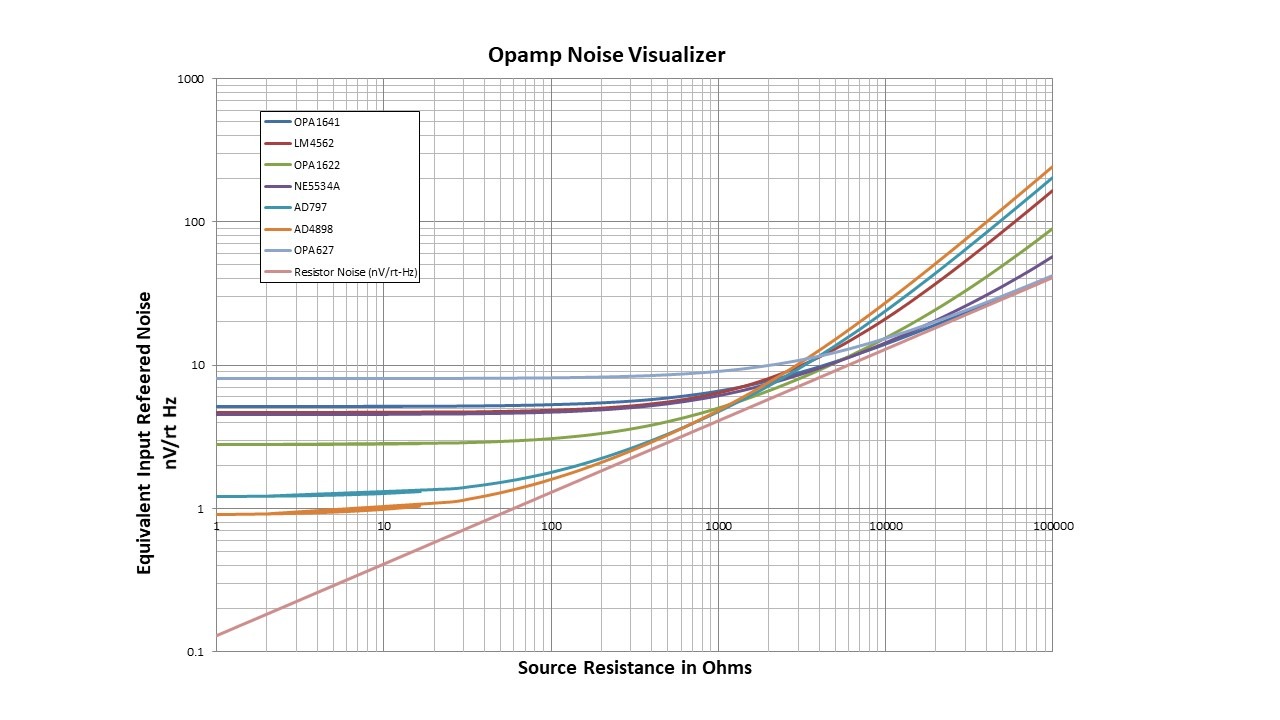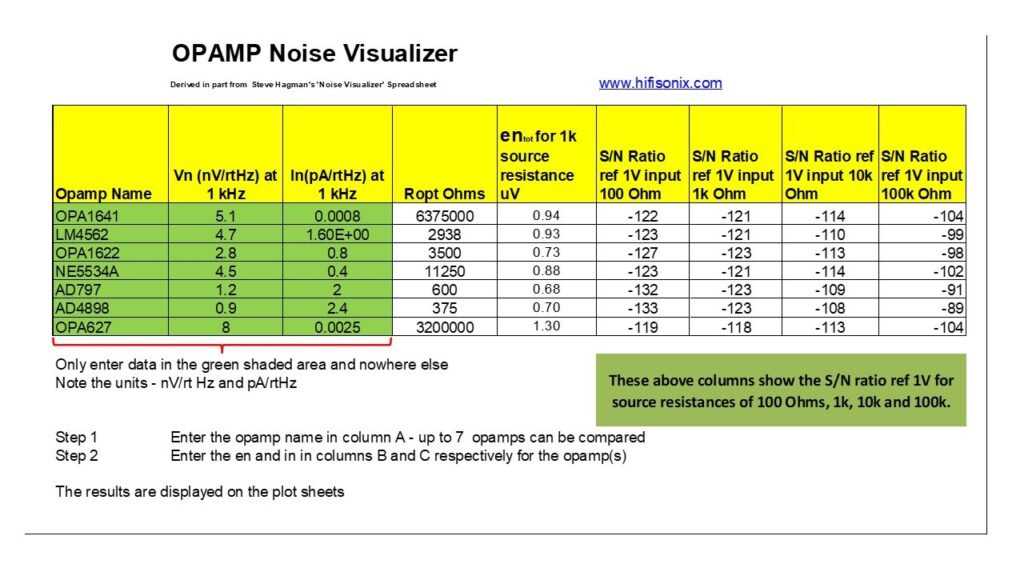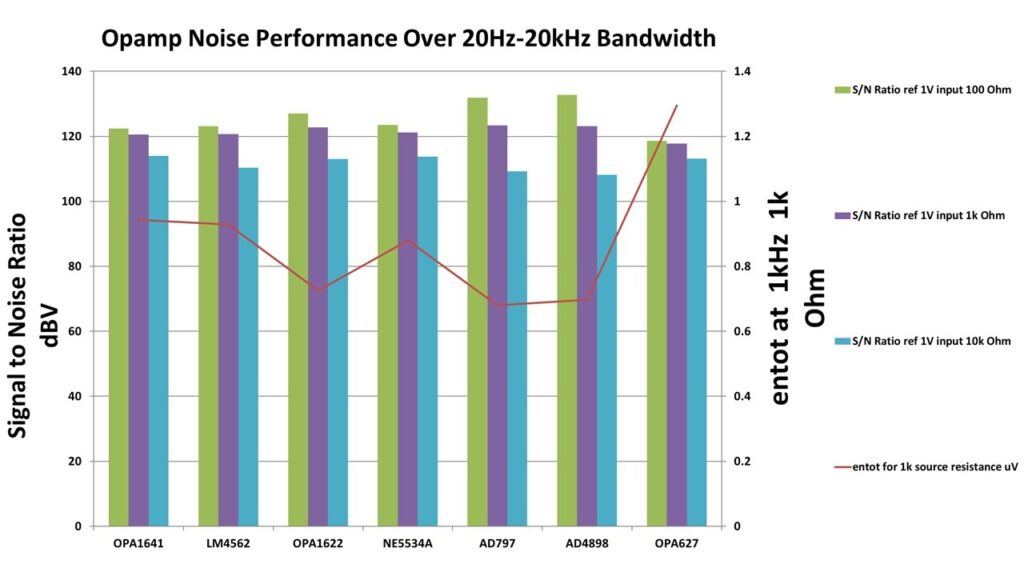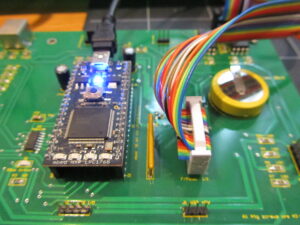Your basket is currently empty!
Blog
-

Opamp Noise Visualizer
This Excel spread sheet tool was developed from one by Steve Hagman (www.AnalogHome.com) and allows en and ien data for up to 7 opamps to be compared. When using the tool, make sure you enter comparable data – so for example, always use the same frequency to make the comparison. I normally use 1 kHz worst case data. For LF noise (where 1/f noise usually dominates and an important consideration for phono equalizers), most manufacturers quote figures at 10Hz, so make sure if you are looking at LF noise data, you use similar frequency point data to make a fair comparison. The tool also contains a system level noise modeller, that allows a signal chain of up to 4 stages to be analyzed, and the resulting S/N ratio and equivalent noise resistor to be calculated.
(The tool was updated 2nd February 2020 after errors were noted by some users)
The definitive document on noise analysis is the classic National Semiconductor AN104 ‘Noise Specs confusing?’ which you can download here AN-104
Below are some screen shots of the Noise Visualizer output.

Data Entry Screen. You Can Enter Data for Up to 7 Opamps to Compare 
S/N Ratio Comparison Output Plot of the Selected Opamps at Rsource = 100, 1k and 10k Ohms 
Noise Visualization for the Selected Opamps Showing en(tot) vs Rsource -
Ovation SCA-1: A high performance fully balanced line pre-amplifier
Originally published in 2010
Here is the result of my investigation in to a fully balanced high performance, low distortion line pre-amp, the ‘Ovation’ Stereo Control Amplifier One’.
I drew some inspiration for this project after reading about the TEAC Esoteric line preamp, which is also based on the TI PGA2320, and received rave reviews from the hi-end press. Esoteric have stuck with the PGA2320 in subsequent models of their line pre-amp and continued to garner excellent reviews. Michael Fremer, of Sterophile fame, said it was one of the best line preamps he had heard at any price – the Esoteric goes for about $10k.
How does my SCA-1 sound? Very open with a smooth mid and upper range. DC coupling throughout means there are no nasties in the LF area either, and overall imaging is excellent.
Ovation SCA-1 Circuit Diagrams
This design is a dual mono fully balanced line pre-amp. Input balanced source selection is via relays, under CPU control via a serial optically isolated bus. The output from the source selection feeds into a dual LM4562 high resolution audio op-amp buffer, and this then feeds into a TI PGA2320, which is configured as a balanced volume control stage. The balanced output from the PGA2320 feeds into an inverting stage configured around an LM4562, with each half of the LM4562 driving an LME49600 buffer. The LM49600’s are inside the LM4562 feedback loop in order to minimize distortion. Since this pre-amp is DC coupled from input throught to output, a servo configured around an AD8512 dual op-amp ensures output offsets are limited to around 200uV worst case.The headphone amplifer is built around an LME49710 high resolution audio op-amp, and the LME49600, again, the buffer inside the op-amp’s feedback loop for the lowest possible distortion.
The entire pre-amp is controlled by an NXP LPC1768 32 bit ARM controller from mbed (see www.mbed.org). The controller is fully optically isolated from the main analog board in order to ensure there are NO noise problems, with separate optically isolated serial busses for each channel. The operating program is written in C and ended up at about 120k bytes including the graphics (the actual I/O part is about 20k bytes long) and is interrupt driven, so when not executing commands from the front panel controls or the remote control, the CPU shuts down, minimizing noise and power consumption. Of course, the use of the optically isolated serial bus also has a big impact on noise performance, where I am aimed for something well under -110dB worst case.
-
Tom D Kite Busts Some Audio Myths!
Ever wondered how we got to ‘feedback is bad’, ‘ . . . sampling destroys the music’ or ‘ . . . analog is 40 bits resolution . . .’ , ‘we need damping factors of 1000’ and ‘ . . . only vinyl sounds good’ ? Tom D Kite PhD, of Audio Precision, takes us on a journey through the myths and then home to the real facts . . . AudioMyths
-
AN-597 Current Feedback Amplifiers
This National Semiconductor application note was written by Hans Palouda and published in 1989. It explains basic CFA operation clearly and concisely.
AN-597 Current Feedback Amplifiers
Here are some other useful application notes and articles that may help in developing an understanding of amplifier topologies and their associated trade-offs.
wiki https://en.wikipedia.org/wiki/Current-feedback_operational_amplifier
EDN https://www.edn.com/design/analog/4458753/In-defense-of-the-current-feedback-amplifier
ADI https://www.analog.com/media/en/training-seminars/tutorials/MT-034.pdf
TI https://cas.ee.ic.ac.uk/people/dario/files/E416/OA-30.pdf
-
CFA’s: An Intuitive Analysis from Intersil
This application note from Intersil provides a simple and easy to understand explanation about CFA operation
-
Small Signal Audio Line Stage Buffer/Headphone Amplifier
This design, which I completed in 2010, takes an LM4562 and marries it to a hefty single ended class A output stage, which can be biased up for either 50 mA or 110 mA. The output stage is included in the global feedback network and can achieve 1 ppm at 20 kHz into 600 Ohms at 3V Output, and about 10 ppm at 10V out into 600 Ohms at 20 kHz.
With the output bias set to 110 mA, this buffer also makes a fine high end headphone amplifier, allowing up to 3 V peak into 32 Ohms, whilst still remaining in class A with ultra low distortion.
A Universal Small Signal Class A Buffer V1.0.pdf
Attention: for a much simpler and more elegant way of forcing the opamp output into class A, see ‘How to Correctly Run and Opamp in Class A‘
-
Stochino Feed Forward Amplifier – Wireless World 1994
This article decribes a feed forward amplifier concept from Giovanni Stochino. The design, while novel, is very complicated and delivers about 30 dB in distortion reduction. Stochino Feed Forward.pdf
For an altogether simpler alternative that acheives about 20 dB distortion reduction, take a look at AFEC (‘augmented feedback error correction’) elswhere on this site.
-
The Quad 405 Current Dumping Amplifier from 1975
The famous Quad 405 ‘Current Dumping’ amplifier was launched in the mid 1970’s, and featured feed forward error correction that effectively removed the class B cross over distortion that plagues this type of output circuit structure. The design featured no adjustments in production, but the circuit components around the output (L2, R36, R38) had to be accurately matched to achieve the specified performance. The design caused quite a stir in the audio industry at the time, and was the subject of a patent and a paper at an AES convention a year earlier. Although the 0.005% midband distortion placed it firmly in the upper eschelons of measured performance in the industry at the time, some reviewers failed to warm to the sound. Nevertheless, this was a landmark design that creatively solved the cross over distortion problem. Quad_405_Power_Amplifier_Wireless World Article.pdf
-
Michael Kiwanuka: SOA Protection for Audio Power Amplifiers
Power Amplifiers, and especially bipolar output designs, require output stage protection in the event of a fault, or the presence of a heavy or highly reactive load.
Michael Kiwanuka explains the intricacies and the design methodology for output stage SOA protection :-



